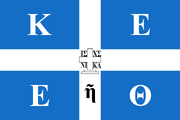Not to be confused with the OTL treaty which ended the Russo-Turkish War of 1877-8.

The Balkans after the treaty
The Treaty of San Stefano, signed by France, Britain, Sardinia, the Ottoman Empire
, Austria, Russia, Greece, Serbia, and Montenegro in October 1855, ended the Danubian War , stripping the Ottoman Empire of nearly all of her European Territories, granting Montenegro, Romania, Serbia, and Bulgaria independence.
Background[]
After the Battle of Yulaflı, the allied command realized that they must negotiate or lose Istanbul to the Russians. On August 22, the allies called a ceasefire. Tsar Nicholas demanded to negotiate in Istanbul, but the allies preferred Paris, eventually settling on San Stefano, a small town on the city's outskirts.
Aims[]
The allies hoped for small territorial changes, some Ottoman Vassals, and some financial indemnities.
The Austrians also preferred vassals, but more nominal ones, along the lines of Ottoman Tunisia or Algeria, with heavy Austro-Russian influences.
Greece desired numerous Aegean islands, autonomy for Greece, as well as OTL northern Greece.
Nicholas I's Pan-Slavic ideals would have none of this. He coveted nothing less than the expulsion of the Ottomans (and the British) from the Balkans, Greek control of the Aegean, Russian annexations of Armenia and Romania, and a Turkey under Russian financial control.
Terms[]
Both the Allies and the Austrians opposed this grand scheme, fearing Russian power. The final treaty consisted of the following points:
- Russian annexation of an area of the Caucuses east of Kars; Austrian annexation of Bosnia and Novi Pazar; Dobruja given to Walachia and Moldavia; Greek annexation of Thessaly, Epirus, Northern Epirus, Chalkidiki, and Western Macedonia.
- Independence of Wallachia, Moldavia, (Under de jure Russian occupation), Montenegro, (Under de jure Austrian occupation), Bulgaria, and Serbia.
- The Russian fleet would be allowed through the Bosporus.
- The Ottomans granted the British naval bases on Crete and Lesbos, while the Greeks let the Russian fleet dock at Salonica.
Further Developments[]

A flag flown during the Cretan revolt. The four letters stand for the motto: "Crete, Enosis (union with Greece), Freedom, or Death." The letters around the cross read, "Jesus Christ Conquers."
Numerous important developments and other diplomatic agreements occurred in the aftermath of the treaty. The princes of Walachia and Moldavia fled at the start of the Danubian War
, and Alexandru Ioan Cuza became prince of both states, unifying them and Dobruja as Romania. In 1859, the Cretans revolted against the Turks and British, hoping to join with Greece. The British crushed the rebels and took control of the island for themselves.
